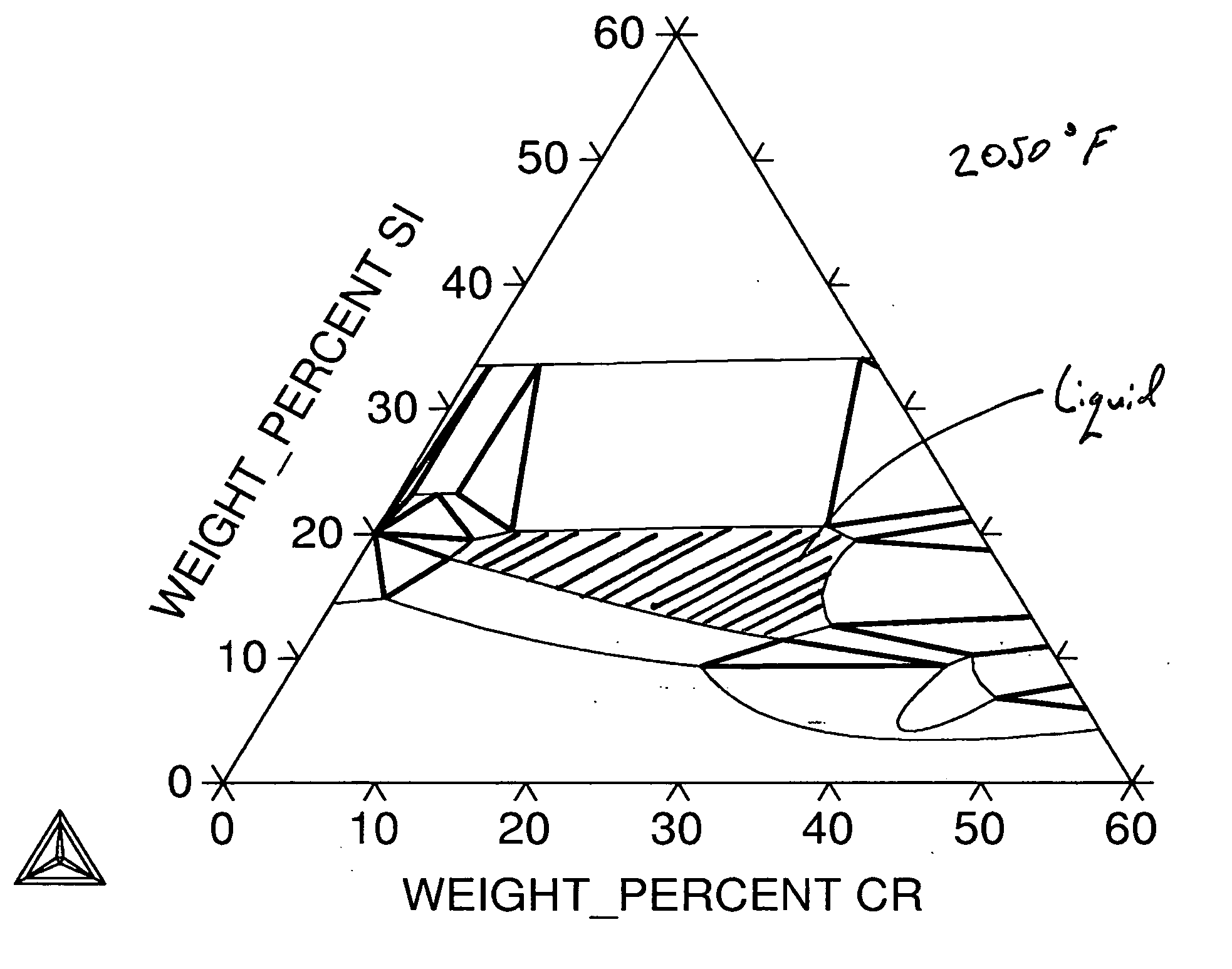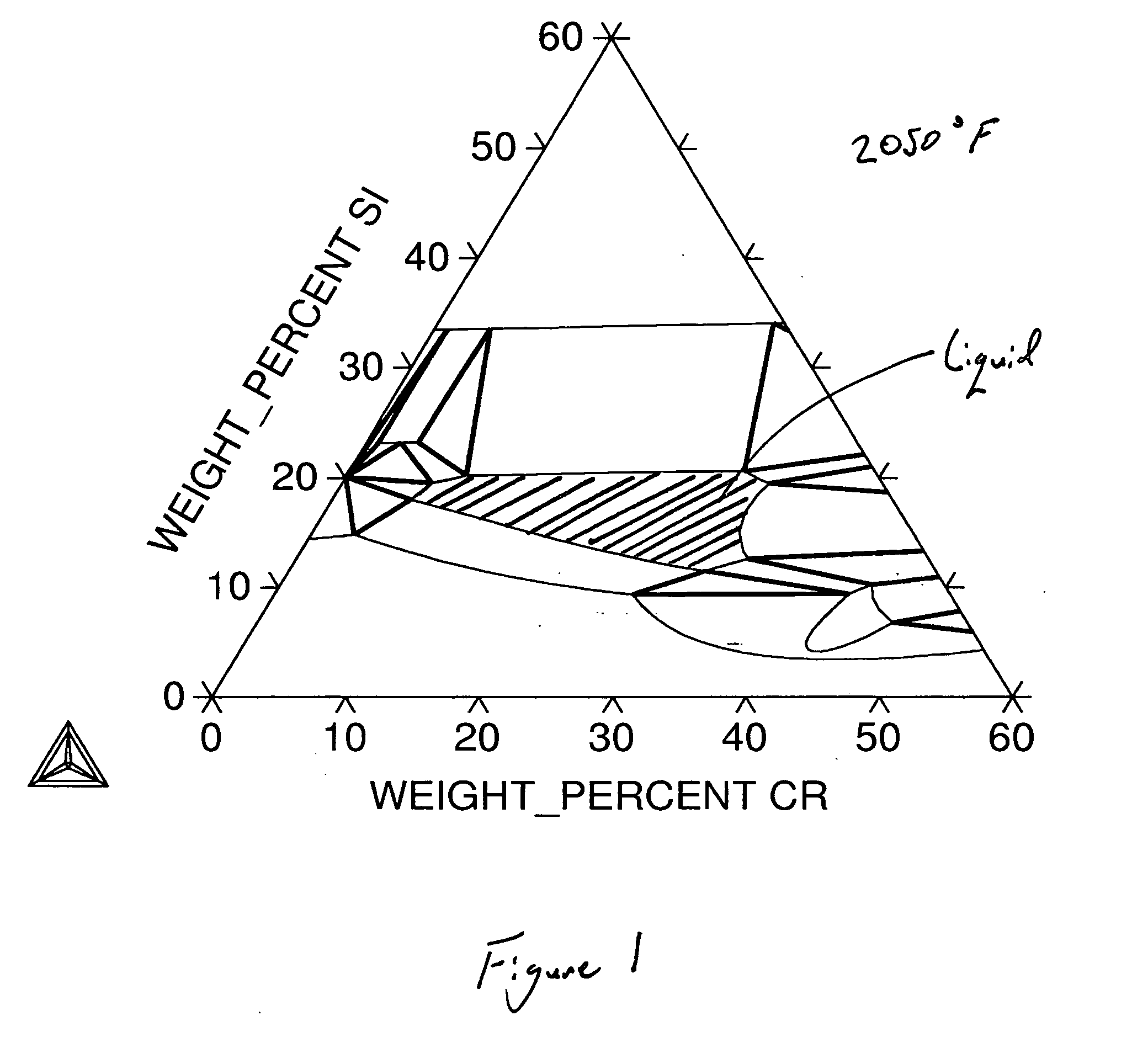Powder metallurgical compositions and methods for making the same
a technology of metallurgical composition and powder, which is applied in the direction of coatings, etc., can solve the problems of affecting the heterogeneous structure of alloyed compositions, and the cost of utilizing commonly used metallurgical additives, and achieve the effect of significantly improving the properties of the final compacted componen
- Summary
- Abstract
- Description
- Claims
- Application Information
AI Technical Summary
Benefits of technology
Problems solved by technology
Method used
Image
Examples
example 1
[0063] Metallurgical powder compositions containing master alloy powders were evaluated and compared to a reference powder without addition of an alloying powder and a reference powder composed of a chromium containing powder additive and a separate silicon containing powder additive. Reference Powder I included an iron based powder admixed with 0.75 weight percent of an ethylene bis-stearamide wax lubricant (commercially available as Acrawax, from Glycol Chemical Co.) and 0.6 weight percent carbon (commercially available as 3203 graphite, from Asbury Graphite Mills). The iron based powder was an iron powder prealloyed with 0.85 weight percent molybdenum (commercially available as Ancorsteel 85 HP, from Hoeganaes Corp.).
[0064] Reference Powder II was prepared by admixing Reference Powder I with an iron-chromium-carbon alloying additive powder having a weight average particle size of 9.3 microns, (commercially available as High Carbon Ferrochrome powder, from F.W. Winter Co.) and a ...
example 2
[0071] Metallurgical powder compositions, Test Compositions I-V, were prepared with master alloy powders having different weight average particle sizes. Each of Test Compositions I-V was prepared by admixing Reference Powder I with a master alloy powder having 24.0 weight percent chromium, 20.0 weight percent silicon, and 56 weight percent iron, based on the total weight of the master alloy. With addition of the master alloy powder, each test composition included 0.4 weight percent chromium and 0.35 weight percent silicon.
[0072] The master alloy powder of Test Composition I, as described in Example I, had a weight average particle size of 11 μm. The master alloy powder of Test Composition II had a weight average particle size of 8 μm. The master alloy powder of Test Composition III had a weight average particle size of 18 μm. The master alloy powder of Test Composition IV had a weight average particle size of 26 μm. The master alloy powder of Test Composition V had a weight average...
example 3
[0081] A metallurgical powder composition composed of master alloy powders, Test Composition I, was compared to reference powders composed of expensive conventional nickel and copper alloying powders. Reference Powder III was prepared the same as Reference Powder of Example 1 except with the addition of 2.0 weight percent of a nickel alloying powder (commercially available as “Inco 123” powder from Inco Limited).
[0082] Reference Powder IV was prepared by admixing an iron-based powder (commercially available as Ancorsteel 1000B from Hoeganaes Corp.), 2.0 weight percent of a copper alloying powder (commercially available as Alcan 8081 from Alcan Inc.), 0.9 weight percent carbon (commercially available as 3203 graphite, from Asbury Graphite Mills), and 0.75 weight percent of an ethylene bis-stearamide wax lubricant (commercially available as Acrawax, from Glycol Chemical Co.), based on the total weight of Reference Powder IV.
[0083] Table 6 shows metallurgical properties for Reference...
PUM
| Property | Measurement | Unit |
|---|---|---|
| weight percent | aaaaa | aaaaa |
| weight percent | aaaaa | aaaaa |
| weight percent | aaaaa | aaaaa |
Abstract
Description
Claims
Application Information
 Login to View More
Login to View More - R&D
- Intellectual Property
- Life Sciences
- Materials
- Tech Scout
- Unparalleled Data Quality
- Higher Quality Content
- 60% Fewer Hallucinations
Browse by: Latest US Patents, China's latest patents, Technical Efficacy Thesaurus, Application Domain, Technology Topic, Popular Technical Reports.
© 2025 PatSnap. All rights reserved.Legal|Privacy policy|Modern Slavery Act Transparency Statement|Sitemap|About US| Contact US: help@patsnap.com



